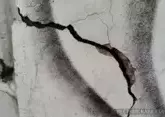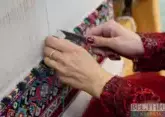Within the framework of the 43rd session of the UNESCO World Heritage Committee, the Azerbaijan Heritage in Louvre Museum exhibition has opened at the Azerbaijan Carpet Museum, which featured three Azerbaijani carpets made in the 18th and 20th centuries in Karabakh and Shirvan - Chelebi, Khanlig and Ajdahaly. These unique exhibits from the Louvre Museum's permanent exhibition are presented in Baku for the first time. Director of the Azerbaijani Carpet Museum Shirin Melikova told Vestnik Kavkaza about the exhibition and the carpets.
- The Azerbaijani carpets from the Louvre Museum exhibition here is an event of a grand scale. It has never happened in Azerbaijan before. Was it difficult to organize such an exhibition?
- The Louvre Museum is the largest museum in the world with a huge collection which reluctantly takes its exhibits abroad, because its own exhibition programs are planned for many years to come. However, in 2012, Azerbaijan was directly involved in the establishment of the Department of Islamic Art at the Louvre, including by providing financial support. Then the foundations of our joint projects were laid.

The official opening ceremony of the new Department of Islamic Arts galleries at the Louvre museum. September 18, 2012
The head of this department came to Baku, held negotiations at the level of the Ministry of Culture. In 2016, when I was appointed the director of the Carpet Museum, one of my first visits was to Paris, where we discussed cooperation possibilities. And when we learned that the 43rd session of the UNESCO World Heritage Committee will be held in Baku, we offered the Louvre to hold an exhibition here as part of this event. But in general, carpets are rarely included in visiting exhibitions, since textiles are very capricious material, it is difficult to store and transport. Therefore, it was difficult to convince the French colleagues, but in the end we succeeded. And they themselves selected these carpets for the Baku exhibition.
- These are not the only Azerbaijani carpets stored in the Louvre?
- Of course not. They have a very large collection. For example, they have a luxurious Shirvan carpet of the 17th century. Its later version is stored in Baku, but still it is one of the gems of our collection. And the Louvre has this carpet of an earlier period! I really wanted to see it at the exhibition next to our carpet. It would be very interesting for both visitors and scientists. But they said the Louvre could not transport it, because it is very fragile.

Nevertheless, very interesting carpets were brought to Baku from the Louvre. Each of them has an element associated with the image of a dragon in one form or another. For example, the Ajdahaly carpet, which means 'dragon', has in the middle such elements as 'ajdahaly buta' (dragon buta), which symbolizes this mythological creature, and a water lily flower ('su zanbağı'), symbolising life. A dragon is traditionally depicted next to a flower or palmette, as a protector and a keeper of life. The Khanlig carpet's corner patterns also depict dragon elements. And the Chelebi carpet's medallions symbolize the sun.

It's worth noting that the name "dragon" is used abroad, but here such a composition used to called 'Khatai', which originates from the name of an ancient Turkish tribe Khatai.
- Are the carpets exhibited here marked as Azerbaijani in the Louvre?
- Yes, precisely as Azerbaijani. But in many museums our carpets are attributed as Caucasian. The issue of attribution was first raised by us in 1983, when the first symposium on the Eastern carpet was held in Baku. Until now, this question has not been clearly resolved. However, the work is underway - the first carpet museum in the world was opened, in 2014 the museum moved to a new building, which became one of capital's architectural landmarks, in 2004 the law on carpet was passed, thanks to our president and first vice president the art of Azerbaijani carpet weaving was added to UNESCO's Representative List of the Intangible Cultural Heritage of Humanity. We are engaged in the study of carpet, we present it at the proper level, we have a scientific base as well. This exhibition has became the Azerbaijan Carpet Museum's contribution to the implementation of the State Program for the Preservation and Development of Carpet Art in the Republic of Azerbaijan for 2018–2022. It was organized by the Ministry of Culture, the Carpet Museum, the French Embassy in Azerbaijan, the Louvre Museum, the French Institute in Azerbaijan and Silk Way West Airlines.
- Are there many Azerbaijani carpets in other museums of the world?
- Yes. There is no museum without Azerbaijani carpets. Within the framework of the State Program for the Preservation and Development of Carpet Art in the Republic of Azerbaijan for 2018–2022, we are closely involved in this, creating an electronic database, and accessing funds. Moreover, we find our carpets in completely unexpected places, in a remote corner of the world, we work with these small museums, carry out authentication. We have a whole department for this purpose. Now the whole world knows about our museum, because we knock on every door.

- All three carpets on display at the exhibition are perfectly preserved. Does it indicate the high quality of materials and the skill of Azerbaijani weavers?
- The quality of carpet is very good. Natural dyes were used to make them. In addition, they are knotted with Turkbaf (Turkic knot - VK) - a symmetrical knot. The West has always treated Oriental carpets with great reverence, they were very expensive, and not everyone had the opportunity to buy them. Often they hung them on the wall instead of laying them on the floor, treated as a piece of art. We recently purchased a carpet from an Italian collector who said: "I never put it on the floor, kept it in a closet in special conditions, and only when I wanted to enjoy this carpet's beauty I spread it, enjoyed it and then put it back so it could be better preserved."
This is one of the reasons that the carpets kept in the West are so well preserved. The second reason is that they were given as valuable gifts, and therefore carpets were treated as a value.
- Was an attitude to carpet weaving the reason to open the world's first carpet museum?
- Azerbaijan is the birthplace of carpets. Carpets exist in many of our traditions, and these traditions are still alive. Special carpets are woven for the wedding, others are kept for funerals, valuable carpets are handed down through the male line, being regarded as a family heirloom. Carpets can be gifted, including to mosques. For example, funds of the largest Turkish museums were replenished with carpets, including those coming from mosques. Some were auctioned and taken out, becoming part of private collections or museum collections in different parts of the world.
- Do you love carpets since childhood?
- We all love carpets from a young age. Each house has carpets that are handed down from generation to generation. We also have such a carpet in our house, which was handed down from grandfather to father, then to me, and further.
- Do the regions continue the tradition of carpet weaving?
- Carpets are woven everywhere here. Recently we visited Shemakha. There was a woman who showed us her carpets: "This is for my eldest daughter. I wove it for my son. We are getting ready for the wedding. And these are the carpets presented me for my wedding ..."
- Are old technologies retained these days? Do they use natural dyes?
- They dye them themselves, they process wool themselves. Therefore, the carpets are a little rough, but unique. In Shamakhi, a woman told us about each element: "This is my home, this is my garden. I did this so that my daughter has happiness, love, and prosperity."
- Do you share the opinion that a weaver's vibe is transferred to the carpet?
- Of course. When you look at the handmade carpet, you have an incredible feeling - you feel the character of the woman who made it. After all, each master interweaves something personal in the ornament.
- Factory carpets are very different from handmade ones?
- All Azerbaijani carpets are manually woven. The only difference is that professional weavers weave carpets according to a sketch, executing every detail with great deliberation, while homeworkers mainly weave from memory, giving free rein to fantasy. Therefore, completely unique carpets are made.
- Can we say that the Azerbaijani carpet weaving has been experiencing a renaissance in recent years?
- Of course! They recover the Azerkhalcha company. Its base, jobs are being restored. The good news is that weavers are mostly young women who see this job as perspective. Recently, Carpet Weavers' Day was established, which also raised the status of the profession. People are proud of their work. Weavers get awards, titles. Providing such support is very important. We have a lot of educational programs both at the university and at the academy, there are also colleges training carpet artists and carpet designers.
Look, almost all personnel in our museum are young people! Our main artist is an experienced person who has been in this business for more than 30 years, but his team is young guys and girls. I'm really glad about it. We often hold exhibitions of our students, their teachers, so that they also have an incentive to work and create.Carpets have always been and will be part of our culture. Various artists draw inspiration from Azerbaijani carpets - and this is wonderful.










